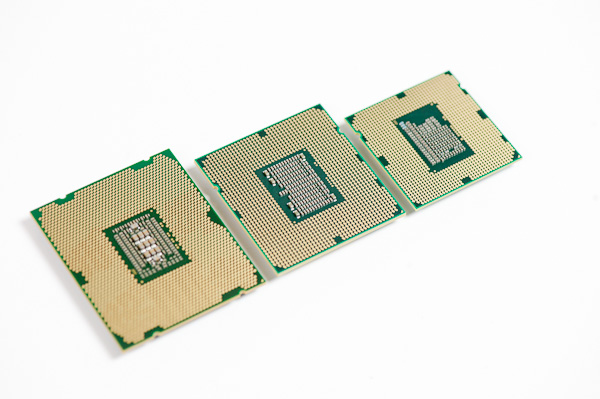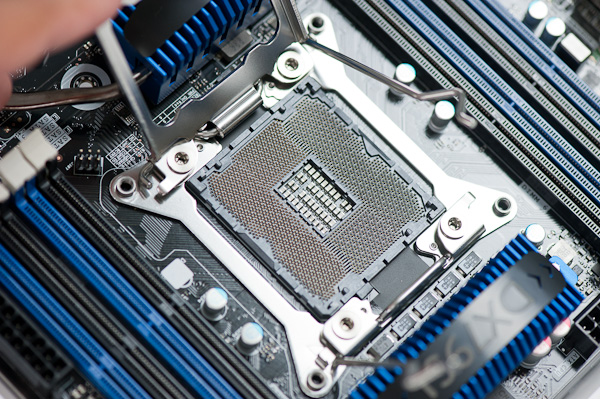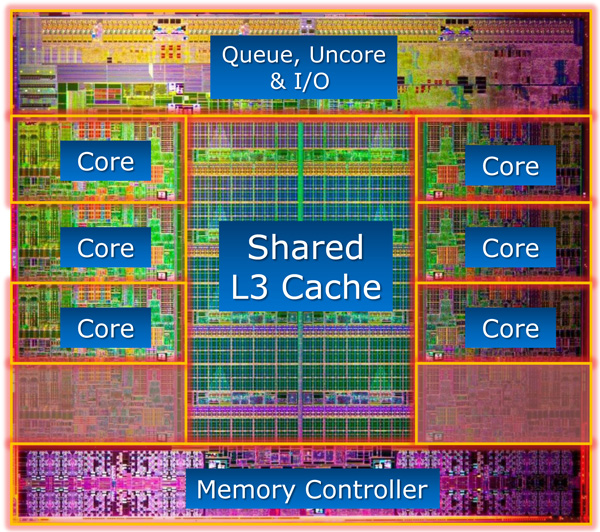Intel Core i7 3960X (Sandy Bridge E) Review: Keeping the High End Alive
by Anand Lal Shimpi on November 14, 2011 3:01 AM EST- Posted in
- CPUs
- Intel
- Core i7
- Sandy Bridge
- Sandy Bridge E
If you look carefully enough, you may notice that things are changing. It first became apparent shortly after the release of Nehalem. Intel bifurcated the performance desktop space by embracing a two-socket strategy, something we'd never seen from Intel and only once from AMD in the early Athlon 64 days (Socket-940 and Socket-754).
LGA-1366 came first, but by the time LGA-1156 arrived a year later it no longer made sense to recommend Intel's high-end Nehalem platform. Lynnfield was nearly as fast and the entire platform was more affordable.
When Sandy Bridge launched earlier this year, all we got was the mainstream desktop version. No one complained because it was fast enough, but we all knew an ultra high-end desktop part was in the works. A true successor to Nehalem's LGA-1366 platform for those who waited all this time.

Left to right: Sandy Bridge E, Gulftown, Sandy Bridge
After some delays, Sandy Bridge E is finally here. The platform is actually pretty simple to talk about. There's a new socket: LGA-2011, a new chipset Intel's X79 and of course the Sandy Bridge E CPU itself. We'll start at the CPU.
For the desktop, Sandy Bridge E is only available in 6-core configurations at launch. Early next year we'll see a quad-core version. I mention the desktop qualification because Sandy Bridge E is really a die harvested Sandy Bridge EP, Intel's next generation Xeon part:
If you look carefully at the die shot above, you'll notice that there are actually eight Sandy Bridge cores. The Xeon version will have all eight enabled, but the last two are fused off for SNB-E. The 32nm die is absolutely gigantic by desktop standards, measuring 20.8 mm x 20.9 mm (~435mm^2) Sandy Bridge E is bigger than most GPUs. It also has a ridiculous number of transistors: 2.27 billion.
Around a quarter of the die is dedicated just to the chip's massive L3 cache. Each cache slice has increased in size compared to Sandy Bridge. Instead of 2MB, Sandy Bridge E boasts 2.5MB cache slices. In its Xeon configuration that works out to 20MB of L3 cache, but for desktops it's only 15MB. That's just 1MB shy of how much system memory my old upgraded 386-SX/20 had.
| CPU Specification Comparison | ||||||||
| CPU | Manufacturing Process | Cores | Transistor Count | Die Size | ||||
| AMD Bulldozer 8C | 32nm | 8 | 1.2B* | 315mm2 | ||||
| AMD Thuban 6C | 45nm | 6 | 904M | 346mm2 | ||||
| AMD Deneb 4C | 45nm | 4 | 758M | 258mm2 | ||||
| Intel Gulftown 6C | 32nm | 6 | 1.17B | 240mm2 | ||||
| Intel Sandy Bridge E (6C) | 32nm | 6 | 2.27B | 435mm2 | ||||
| Intel Nehalem/Bloomfield 4C | 45nm | 4 | 731M | 263mm2 | ||||
| Intel Sandy Bridge 4C | 32nm | 4 | 995M | 216mm2 | ||||
| Intel Lynnfield 4C | 45nm | 4 | 774M | 296mm2 | ||||
| Intel Clarkdale 2C | 32nm | 2 | 384M | 81mm2 | ||||
| Intel Sandy Bridge 2C (GT1) | 32nm | 2 | 504M | 131mm2 | ||||
| Intel Sandy Bridge 2C (GT2) | 32nm | 2 | 624M | 149mm2 | ||||
Update: AMD originally told us Bulldozer was a 2B transistor chip. It has since told us that the 8C Bulldozer is actually 1.2B transistors. The die size is still accurate at 315mm2.
At the core level, Sandy Bridge E is no different than Sandy Bridge. It doesn't clock any higher, L1/L2 caches remain unchanged and per-core performance is identical to what Intel launched earlier this year.
The Lineup
| Processor | Core Clock | Cores / Threads | L3 Cache | Max Turbo | Max Overclock Multiplier | TDP | Price |
| Intel Core i7 3960X | 3.3GHz | 6 / 12 | 15MB | 3.9GHz | 57x | 130W | $990 |
| Intel Core i7 3930K | 3.2GHz | 6 / 12 | 12MB | 3.8GHz | 57x | 130W | $555 |
| Intel Core i7 3820 | 3.6GHz | 4 / 8 | 10MB | 3.9GHz | 43x | 130W | TBD |
| Intel Core i7 2700K | 3.5GHz | 4 / 8 | 8MB | 3.9GHz | 57x | 95W | $332 |
| Intel Core i7 2600K | 3.4GHz | 4 / 8 | 8MB | 3.8GHz | 57x | 95W | $317 |
| Intel Core i7 2600 | 3.4GHz | 4 / 8 | 8MB | 3.8GHz | 42x | 95W | $294 |
| Intel Core i5 2500K | 3.3GHz | 4 / 4 | 6MB | 3.7GHz | 57x | 95W | $216 |
| Intel Core i5 2500 | 3.3GHz | 4 / 4 | 6MB | 3.7GHz | 41x | 95W | $205 |
Those of you buying today only have two options: the Core i7-3960X and the Core i7-3930K. Both have six fully unlocked cores, but the 3960X gives you a 15MB L3 cache vs. 12MB with the 3930K. You pay handsomely for that extra 3MB of L3. The 3960X goes for $990 in 1K unit quantities, while the 3930K sells for $555.
The 3960X has the same 3.9GHz max turbo frequency as the Core i7 2700K, that's with 1 - 2 cores active. With 5 - 6 cores active the max turbo drops to a respectable 3.6GHz. Unlike the old days of many vs. few core CPUs, there are no tradeoffs for performance when you buy a SNB-E. Thanks to power gating and turbo, you get pretty much the fastest possible clock speeds regardless of workload.
Early next year we'll see a Core i7 3820, priced around $300, with only 4 cores and a 10MB L3. The 3820 will only be partially unlocked (max OC multiplier = 4 bins above max turbo).


















163 Comments
View All Comments
mino - Monday, November 14, 2011 - link
"Quick Sync leverages the GPU's shader array"This is simply not true. And you know it. Shame.
Steelski - Tuesday, November 15, 2011 - link
irrelevant CS4 test because someone buying this kind of hardware would appreciate the CS5 advantage other websites show.jewie27 - Tuesday, November 15, 2011 - link
I was waiting for X79 but after I read the initial reviews I bought a Z68 motherboard and 2500K cpu for gaming.C300fans - Tuesday, November 15, 2011 - link
Me too. 999$+X79 for 0% improvement in gaming. What a crab! Bulludozer seems not that crab comparing to 3960x overall.yankeeDDL - Tuesday, November 15, 2011 - link
Making unsubstantiated claims about something that is non-intuitive falls, in my dictionary, under fanboy-ism (if that's a word).The fact that Win7 "runs better" on a certain, relatively old, PC, is one thing. Stating that Windows7 is faster than XP (in spite of a documented benchmark proving otherwise) is another one.
Like I said, you can compare OS in terms of HW support, ease of use, even responsiveness, however, neither of those translate into one OS beinf "faster".
Faster means that when you run a benchmark (pick any of the ones that Anand run in this article), you get a noticeable increase in speed.
The OSes provide the infrastructure to run applications, they cannot provide any fundamental speed difference, unless, of course, you have a PC without enough RAM, for example, and in that case the OS that uses less RAM will have an obvious advantage (because it offers more "free" RAM for apps to run), but that again, has nothing to do with one OS being faster: if anything, it is more efficient.
I have 4GB on both my laptop (Win7) and on my desktop (WinXP) and the difference is negligible: I nearly always have more than 2GB of RAM committed, so it is no surprise that on your PC Win7 with ReadyBoost is faster: just spend ~$15 on 2GB of RAM and you'll see a huge performance improvement both on XP and 7.
jmelgaard - Tuesday, November 15, 2011 - link
So "Faster" must not apply to the OS's capability to respond to the user, it must only apply to the OS's capability to server application requests?...Wait what?...
Kob - Tuesday, November 15, 2011 - link
You guys need to look at the engineering of your requests: 6 sata3 ports require feeding 6*6gb/s = 36 Gb/s data, while the total max theoretical mem bw of the chipset is 37 Gb/s. Can't do that while also taking care of OS, apps and video memory requirements.cbutters - Monday, December 12, 2011 - link
6*6gb/s isn't going to be happening constantly.....you build out one bridge that has a certain amount of bandwidth, 12GB perhaps, I don't know, and let the ports use the available shared bandwidth, doesn't mean you can't add additional ports, this is one of the benefits of serial interfaces.C300fans - Tuesday, November 15, 2011 - link
Intel Gulftown 6C 32nm 6 1.17B 240mm2Intel Sandy Bridge E (6C) 32nm 6 2.27B 435mm2
SB-E, What a crab! Double Transistors, Double size, merely 20% gain from SB 2600k. 999$ for this? I would rather get 2 pcs Interlagos 6200 instead.
sna1970 - Tuesday, November 15, 2011 - link
using 5870 CF to show us that dual 8x PCIE are same as dula 16x is a mistake I am shocked some one like you fall in ...you should have tested 6990 in CF , or 590 ... and see the difference between 16x SLI/CF and 8x SLI/CF
and how do you consider a 5870 a MODERN GPU ?
Quote : "Modern GPUs don't lose much performance in games, even at high quality settings, when going from a x16 to a x8 slot."
Answer : WRONG . try high end dual GPU cards in SLI/CF !